Aug. 06, 2021
Combinación entre displasia de cadera y pinzamiento
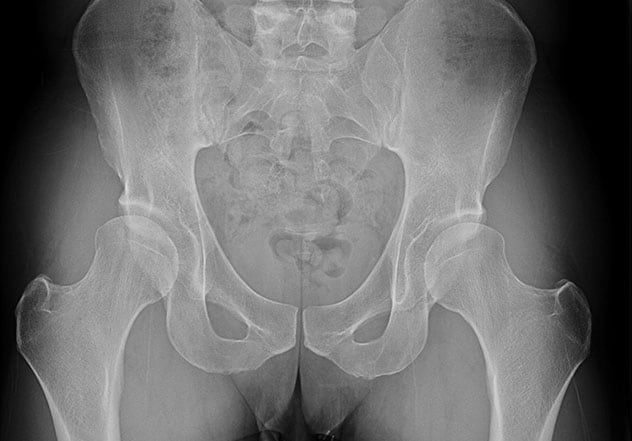
Combinación entre displasia de cadera y pinzamiento
Una radiografía de preoperatorio muestra la compleja afección de un hombre de 26 años con una combinación entre displasia de cadera y pinzamiento debido a una anomalía en la unión de cabeza y cuello y retroversión femorales.
Artroscopia de cadera
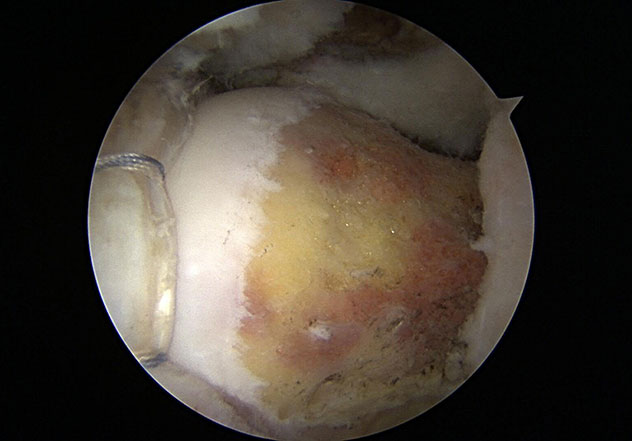
Artroscopia de cadera
Una imagen intraoperatoria muestra una artroscopia de cadera realizada después de un procedimiento de reparación del labrum y de osteocondroplastia de unión de cabeza y cuello femoral.
Corrección cuatro meses después del tratamiento
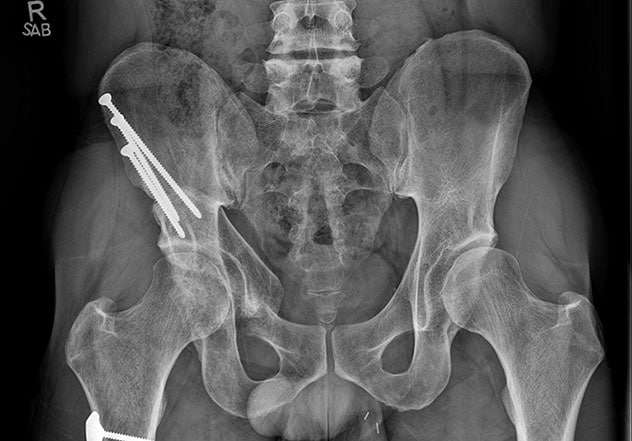
Corrección cuatro meses después del tratamiento
Una radiografía que se realizó cuatro meses después del tratamiento muestra una corrección posterior a la osteotomía periacetabular, resección de la lesión tipo cam y osteotomía desrotadora femoral.
The hip and pelvic problems experienced by young adults have multiple and often complex etiologies. Treatment options vary, further complicating decisions about the optimal approach for an individual patient. Mayo Clinic addresses these issues through a multidisciplinary Young Hip Clinic.
"Bringing together a number of different specialties allows for a comprehensive approach," says Rafael J. Sierra, M.D., chair of Adult Reconstruction, Orthopedic Surgery, at Mayo Clinic in Rochester, Minnesota. "We are able to provide a spectrum of treatment options, including operative and nonoperative management, that are individualized to the patient."
Hip dysplasia and femoroacetabular impingement (FAI) are the most common conditions treated. But specialists in the Young Hip Clinic also treat pelvic conditions, including sacroiliac joint pain, athletic pubalgia and buttock pain from various etiologies, including ischiofemoral impingement. "We see patients who have been labeled as having hip pain, but their pain could be a combination of factors including pelvic-associated pain," Dr. Sierra says.
Precise diagnosis of young athletic hip and pelvic injuries can be challenging. "Many different injuries can present with similar symptoms," says Aaron J. Krych, M.D., co-chair of Sports Medicine, Orthopedic Surgery, at Mayo Clinic's campus in Minnesota. "In addition, the same injury can require very different management, depending on the patient's activity requirements and goals."
The Young Hip Clinic treatment team also includes orthopedic surgeons with expertise in trauma care, physical medicine and rehabilitation specialists, and physical therapists.
Defining and treating an individual's pathology
Buena resección de la lesión tipo cam
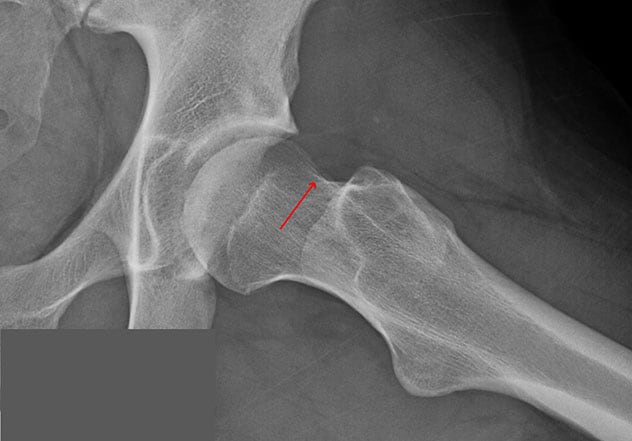
Buena resección de la lesión tipo cam
Una radiografía muestra lo que parece ser una buena resección de la lesión tipo cam (flecha roja) en un hombre de 24 años que se presentó en Mayo Clinic con un dolor de cadera continuado después de dos procedimientos de artroscopia de cadera que se realizaron en otro lugar.
Zonas de pinzamiento de lesión de tipo cam residual
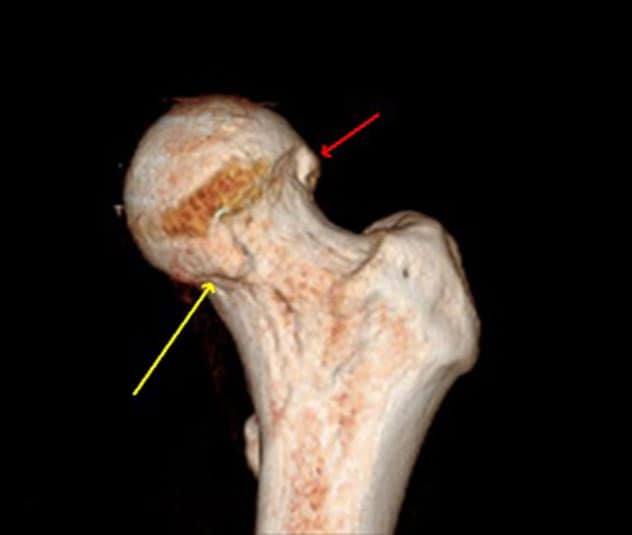
Zonas de pinzamiento de lesión de tipo cam residual
Una tomografía computarizada en 3D muestra zonas extensas de pinzamiento de lesión de tipo cam residual (flechas amarillas y rojas) en la cadera de un hombre de 24 años que se presentó en Mayo Clinic con dolor de cadera continuado después de dos procedimientos de artroscopia de cadera que se realizaron en otro lugar.
Imaging is key to managing complex hip and pelvic conditions. Nonoperative specialists in Sports Medicine at Mayo Clinic — Jacob L. Sellon, M.D.; Jeffrey M. Payne, M.D.; and Elena (Ellie) J. Jelsing, M.D. — have expertise in ultrasound evaluation of painful joints as well as joint injections. Mayo Clinic has also developed high-definition and 3D CT and MRI to evaluate hip and pelvic injuries.
"Each patient presents with unique pathology," Dr. Krych says. "State-of-the-art imaging allows us to evaluate the primary root of the problem and the secondary consequences of that pathology, and then to recommend the treatment needed to relieve pain, restore function and prevent future injury."
Nonsurgical treatment is initially pursued if feasible. When surgery is needed, specialists consult to determine whether an arthroscopic or open approach would be more beneficial. At Mayo Clinic's campus in Minnesota, the adult reconstruction and sports medicine divisions are located on adjacent floors in the same building.
"We are able to connect regularly to review images, see patients, and decide if an arthroscopic or open approach is appropriate," Dr. Sierra says. "If a sports medicine physician thinks a patient needs to see a surgeon who does open hip surgery, that's often possible on the same day."
Both approaches might be necessary — for example, for individuals with hip dysplasia and secondary intra-articular joint damage. Mayo Clinic has orthopedic surgeons with experience in periacetabular osteotomy (PAO) and other open surgeries as well as hip arthroscopy. "Together, an open and an arthroscopic approach can treat current symptoms and prevent further deterioration of the joint or reinjury," Dr. Krych says.
Some orthopedic surgeons at Mayo Clinic have experience with both open and arthroscopic procedures. "But for patients with more-complex problems, we use a team approach, with a sports medicine specialist performing the hip arthroscopy and a reconstruction specialist performing the open procedure," Dr. Sierra says. "The procedures might be performed under a single anesthesia. But if the patient's condition is very complex, two surgeries in a single setting might take too long. In that case, we separate the procedures by at least a month."
Most people treated in the Young Hip Clinic report significant relief from pain. "We know that three-fourths of people with untreated hip dysplasia will experience some hip degeneration and arthritis within 20 years," Dr. Sierra says. "Ultimately, we want to help these patients avoid hip replacements. Our research has shown that treatment at a young age cannot only relieve immediate pain but also can change the natural history of the condition."
Cutting-edge research and clinical trials
Research and clinical trials are important aspects of Mayo Clinic's efforts to manage hip conditions. A study redefining the natural history of osteoarthritis in people with hip dysplasia and impingement received the John Charnley Award in 2017. In the January 2021 issue of American Journal of Sports Medicine, Mayo orthopedic surgeons defined the incidence of FAI in the general population and the increase in diagnoses of FAI between 2000 and 2016.
Patients treated at the Young Hip Clinic might also be eligible to participate in clinical trials. Mayo Clinic is leading a randomized trial evaluating treatment outcomes for individuals with hip dysplasia who have concomitant hip arthroscopy during PAO compared with patients treated with PAO alone.
"Right now, we don't completely grasp whether arthroscopy is always beneficial with PAO. This trial will advance the science of treating these conditions," Dr. Sierra says. Mayo Clinic is also participating in a multicenter clinical trial, funded by the Department of Defense, that is investigating predictors of outcomes for FAI.
In addition, Mayo's orthopedic surgeons are working to improve surgical techniques. One project involves the use of 3D-printed surgical guides for patients having PAO. In another effort, Mayo's engineering specialists are working to develop finite element analysis to improve the positioning of the hip during surgery to better prevent arthritis.
"What's truly unique about the Young Hip Clinic is the number and range of specialties that we utilize," Dr. Sierra says. "It's a new, holistic approach to care for these patients."
For more information
Wyles CC, et al. The John Charnley Award: Redefining the natural history of osteo-arthritis in patients with hip dysplasia and impingement. Clinical Orthopaedics and Related Research. 2017;475:336.
Hale RF, et al. Incidence of femoroacetabular impingement and surgical management trends over time. American Journal of Sports Medicine. 2021;49:35.
Mayo Clinic. Clinical Trial of Concomitant Hip Arthroscopy During PAO. ClinicalTrials.gov.
Washington University School of Medicine. Identification of Predictors for Clinical Outcomes in Femoroacetabular Impingement Surgery (DoD FAI-2). ClinicalTrials.gov.